34 Aerodynamics of Finite Wings
Introduction
When the flow passes over a finite wing, i.e., a wing with a definite span from tip to tip, the downstream flow is characterized by forming a trailing wake system comprised of swirling flows called wingtip vortices, as shown in the annotated photograph below. These vortices resemble horizontal tornadoes and contain high rotational “induced” flow velocities, particularly near their centers, extending outward for more than a wing span. The vortices left in the path behind the wing significantly affect the airplane’s aerodynamics, primarily reducing its lift and increasing its drag. Wing-generated vortices will form along the edges of the wing tips (or at the end of the winglet) or wherever else on the wing there is a significant spanwise change in the pressure and lift distribution, such as at the side edges of the flaps.
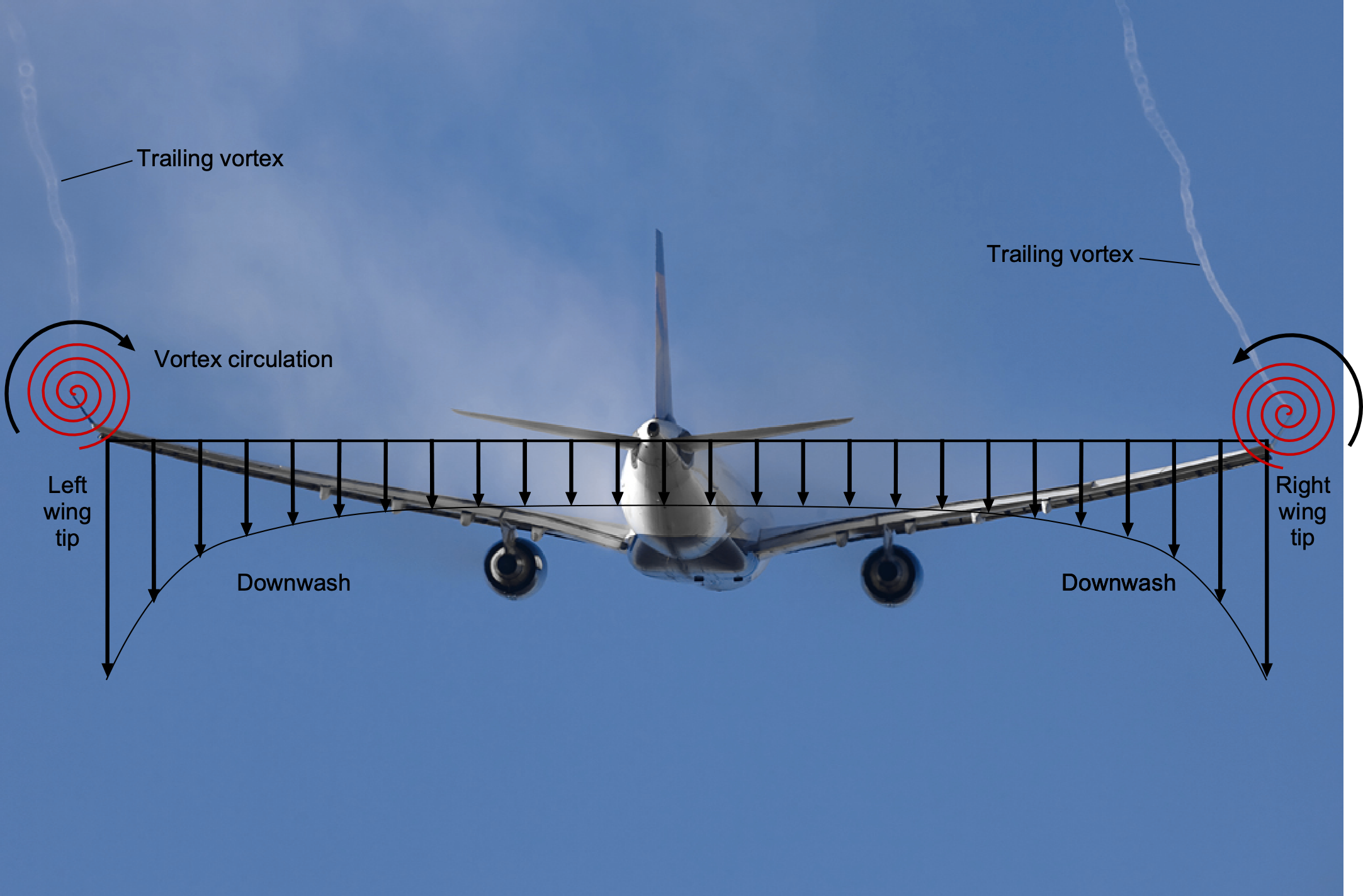
The most significant aerodynamic effects of these wing tip vortices, or tip vortices , are on the airplane’s wing, producing a vertical downwash flow velocity over its surface, especially near the wing tips. This downwash is of sufficient magnitude to alter the angle of attack of every wing section and, subsequently, the amount of aerodynamic lift and drag produced on the entire wing. The type of drag caused by wingtip vortices is called induced drag. Consequently, finite-span wings have different aerodynamic characteristics from those of two-dimensional airfoils. The wing’s aerodynamic characteristics, such as lift and drag, depend on its shape, including its chord distribution, span, spanwise twist, and other factors, such as the presence of a winglet. The addition of underslung engines can also affect the spanwise lift distribution, which, in turn, further affects lift and drag.
Learning Objectives
- Appreciate the physical nature and effects of the trailed wake system behind a wing of finite span.
- Understand the essential aerodynamic characteristics of finite wings, including the effects of wing aspect ratio on lift and drag.
- Know how to interpret and use a drag polar for a finite wing and an airplane.
Origin of Trailing Vortices
The formation of vortices behind finite wings has been studied for over a century. Frederick Lanchester conducted some of the first investigations in the early 1900s, and his book on the subject eventually led to the development of modern wing theory. By any aerodynamic standard, the formation of a tip vortex is a complex fluid-dynamic phenomenon. It is known that when combined with the freestream flow, the flow in the tip region moves from the lower to the upper surface and begins to rotate, forming a swirling, or vortical, flow that trails behind the airplane.
The photograph below shows this significant aerodynamic behavior, visualized using smoke ejected into the wake behind a Boeing 747. The strengths of these vortical flows depend on the magnitude of the pressure gradient at the wing and on the tip shape, which, in turn, affect the lift distribution on the wing. A short distance downstream of the wing’s trailing edge, the outer wing tip vortices in the photograph are rolled up rather tightly.

To explain the underlying flow physics of tip vortex formation, it is essential to remember that a static pressure difference exists between the upper and lower surfaces, which is the source of lift on the wing. Research has shown that the tip vortex originates from the tendency of the flow to curl around the wing tips because of the pressure gradient acting there, as illustrated in the schematic below. In this regard, the pressure naturally tends to equalize, causing the flow to move from the higher pressure on the lower surface to the lower pressure on the upper surface. The consequence of this behavior is the initiation of a rotational motion in the flow, which marks the beginning of wing tip vortex formation.

The inherent three-dimensionality of the flow at the wing tip and the formation of the tip vortex have been extensively researched over many decades. This research employs a range of experimental and computational methods, such as computational fluid dynamics (CFD), as illustrated in the example below. These results, which can be plotted in terms of flow velocity, pressure, and other variables, have revealed the complex and intricate aerodynamics of the vortex roll-up. This roll-up process concerns the presence and interaction of three-dimensional boundary layers, flow separation, and shear layers at the wing tip. The tip vortex is usually tightly rolled up within 2 to 3 chord lengths behind the wing. It will then slowly diffuse and spin down under the action of viscosity and turbulence.

One research finding is that tip vortex formation is an evolutionary process. It takes some downstream distance before the vortices become fully formed behind a wing. Once they are created, however, they remain persistent, spinning down only slowly under the action of viscosity and turbulence. Another concern is the potential impact of wingtip vortices on a following airplane, particularly near airports.
Natural condensation of water vapor over an airplane wing
When an airplane flies, the airflow over the wing causes changes in pressure and temperature. Condensation can occur if the temperature drops sufficiently, resulting in visible vapor trails or fogging on the wing. As air flows over the wing, its speed increases, leading to a decrease in pressure according to Bernoulli’s equation, i.e.,
where is the air density,
is the airspeed, and
is the local flow velocity, with
and
being the corresponding pressures. This pressure drop,
, results in a corresponding decrease in temperature, which can be described by the adiabatic relationship
where is 1.4 for air. For condensation to occur, the local flow temperature
must be less than or equal to the dew point temperature
, i.e., the air’s saturation temperature. Therefore, the condition for natural condensation effects to occur is
When this condition occurs, typically in humid conditions or near clouds, the flow becomes visible as vapor trails from wing tips, flap side edges, and engine nacelles. The photo below shows an example of the latter.

Effects of Trailing Vortices
The induced velocity field from the wingtip vortices is shown in the figure below. Near the center of the vortex, the induced velocity is relatively high. However, the induced velocity decreases inversely with distance from the vortex, so by a semi-span away, the effects diminish significantly. The core region of the wingtip vortex experiences more substantial viscous effects, so it rotates more like a solid body. The core is typically very small, however, of the order of 10% of the wingtip chord.

It will now be apparent that the aerodynamic effects of these rolled-up vortices (one from each wingtip) are significant. First, because of their swirling-induced flow field, they will produce a downwash at each wing section. The principle is shown in the figure below. Adding the downwash flow vector to the freestream flow vector
produces a resultant flow velocity (or local relative wind) that turns through an angle
, called the induced angle of attack. It will be apparent from this figure that the resultant flow now approaches the wing at a different angle, creating an “effective” angle of attack,
.

From the geometry of the problem shown above, the induced angle is given by
(1)
which will, in general, be different at each station on the wing, i.e., and
. For small angles, which are typical for a wing, it is sufficient to write that
(2)
or, in general, that
(3)
Therefore, the effective (and lower) angle of attack of the wing section is now
(4)
or, in general, that
(5)
This outcome means that the corresponding lift per unit span will be reduced from its two-dimensional value, i.e., the lift obtained in the absence of downwash. Notice that because will typically be much smaller than
, then the resultant velocity,
, can be assumed to be equal to
, i.e.,
(6)
In this situation, it is particularly significant that the lift vector changes orientation and is slightly rearward of its original direction in two-dimensional flow, thereby reducing the vertical component of the lift. Remember that the lift force, by definition, acts perpendicular to the relative wind, so in this case, it can be seen in the figure above that the lift vector rotates rearward through a slight angle , as does the drag. The consequence is that there is now a component of the lift that acts in the downstream direction, which is called the induced drag,
, i.e.,
(7)
The induced drag component, , is often called “the drag due to lift” because its origin is primarily a consequence of the formation of the wing tip vortices, and these vortices will only form when the wing creates lift. Therefore, the higher the induced downwash from the wing tip vortices, the higher the induced drag, as illustrated in the figure below.

Remember that and
represent forces per unit length at each section of the wing, which, in general, will be different, i.e.,
and
. Therefore, the total lift and drag on the wing must be obtained by spanwise integration. Consequently, the total wing lift,
, will be given by
(8)
where varies from
at the left wing tip to
at the right wing tip. Similarly, the total induced drag on the wing is given by
(9)
Wing Force & Moment Coefficients
When force and moment coefficients are defined for finite wings, a reference length, such as a chord length, and a reference area are needed. The reference area is usually the projected or planform wing area, . The dimensionless coefficients for a finite wing are defined as:
Lift coefficient,
Drag coefficient,
Normal force coefficient,
Axial (chord) force coefficient,
Moment coefficient about some point ,
Recall that for finite wings, it is generally the convention that the “wing area,” , is based on the projected planform wing area and not the actual (wetted) surface area. Wing area is obtained by integrating the distribution of wing chord along the span from one wing tip to the other, i.e.,
(10)
where . It is important to distinguish the wing area (symbol capital
) from the semi-span of the wing (symbol lowercase
). Notice that the reference area,
, may be defined as the body’s maximum cross-sectional area for bodies such as airplane fuselages or road vehicles. Other than for wings, the reference area may not be unique, and standard conventions should always be used when defining force and moment coefficients.
Notice also in these preceding definitions of the coefficients the use of a reference length in the definition of the moment coefficient. For a finite wing,
is usually defined as the standard mean chord (SMC) or mean aerodynamic chord (MAC). The SMC is defined as
(11)
which, like the wing area, may need to be obtained by spanwise integration. The MAC is
(12)
which, like the wing area, may need to be obtained by spanwise integration. Usually , although in some cases
may be used. It is important to note the specific definition being used in any application. For rectangular wings, it will be apparent that
.
Measured results for the lift coefficient, , and the drag coefficient,
, are shown in the figure below for a wing with
= 4. The tests were done at a low Mach number, so the compressibility effects are negligible. Results for two Reynolds numbers, 700,000 and 1,000,000, are shown, which were achieved by varying the flow speed.

Check Your Understanding #1 – Finding the lift coefficient of a wing
The wing of a general aviation airplane has a rectangular planform with a span of 30 feet and a chord of 5.25 feet. The airplane has an in-flight weight of 2,105 lb and is cruising at a true airspeed of 120 kts at a pressure altitude of 3,000 ft, where the outside air temperature is 72F. Calculate the lift coefficient of the wing. Assume that the wing carries all of the lift.
Show solution/hide solution.
Because we can assume that lift = weight in level flight, i.e., , then the lift coefficient,
, is
Therefore, we need to find the wing area (planform area), , and the air’s density in which it flies,
. It is a rectangular wing, so the wing area is 30 x 5.25 = 157.5 ft
. The pressure altitude is 3,000 ft with an outside air temperature of 72
F. ISA standard temperature at 3,000 ft is 57 – 3.57 x 3 = 48.29
F, so 25.71
F warmer than standard. From ISA properties, then
slug/ft
. We are also given the true airspeed,
, in knots (kts), which must be converted to feet per second (ft/s); i.e., 120 kts = 202.54 ft/s. Therefore, the operating lift coefficient of the wing is
Drag Polar for a Finite Wing
The net effect of these wing tip vortices on the entire wing, therefore, is a reduction in the lift (for a given angle of attack) and an increase in drag, the primary dependency being the effects of wing span and, specifically, the aspect ratio, as shown in the figure below in terms of the drag polar. These classic results, which are wind tunnel measurements from Ludwig Prandtl’s original work on the subject with his students over a century ago, demonstrate that the wing’s aspect ratio has a significant impact on both lift and drag. Recall that the aspect ratio of the wing, , is defined as the ratio of the square of the wing span to the wing reference area, i.e.,
(13)

The Wright brothers discovered the importance of the aspect ratio!
The Wright brothers noticed the importance of aspect ratio in their wind tunnel experiments in 1900, and the results were reflected in the design of their “Flier” in 1903. Unlike others at the time, including Lilienthal, Whitehead, and Langley, they recognized that the ability to build and fly a high-aspect-ratio wing was crucial to successful flight, given their limited engine power. Listen to Professor John Anderson discuss the topic of aspect ratio.
The results in the figure above confirm that the aspect ratio of a wing is critically important in aerodynamic analysis because a higher lift-to-drag ratio can be obtained with wings of a higher aspect ratio, i.e., a long, slender wing with a large span relative to its average chord. The physical reason is that the higher the aspect ratio of the wing, the farther the tip vortices are away from the remainder of the wing. Therefore, their effects result in a lower downwash over the wing and a lesser impact on the three-dimensional aerodynamics.
A reminder of the significance of the drag polar, in this case for a finite wing, is now appropriate because it forms a basis for understanding total airplane performance. An annotated version of a representative polar is shown in the figure below. Notice that the slope of a straight line running from the origin of the graph at (0, 0) to any point on the polar curve is the lift-to-drag ratio of the wing at that operating point.

The tangent point of the line to the drag polar represents the highest slope, and so the operating point for the best lift-to-drag ratio, i.e., the best or
, which can be seen to occur at one specific value of the lift coefficient for a given wing as well as its operating Reynolds number and Mach number. The value of
represents the part of the drag that is relatively constant and independent of the lift coefficient, i.e, the sum of skin friction and pressure drag or the so-called “parasitic drag, which is sometimes just called “form drag” or “profile drag.”
Calculating the Lift & Drag on a Finite Wing
The lift and drag on a finite wing can be deduced from using the conservation laws in integral form. An elliptical wing planform with an elliptical spanwise lift distribution produces a constant spanwise value of the induced angle of attack, , and a flow with a constant downwash angle
in the trailing wake. This result is derived from far-field wake theory, based on the Helmholtz vortex theorems and the Biot-Savart law. Therefore, there is a vertical change in the time rate of change of momentum of the flow as it passes about the wing and turns through an angle
. Using these principles, the force on the fluid to increase its vertical momentum can be established, and the reaction force is then the lift on the wing.
Consider a control volume that encloses the wing and the trailing wake, within which the flow is deflected downward by a slight angle , as shown in the figure below. The mass flow rate through this streamtube is approximately
where
is the cross-sectional area of the induced flow tube around the wing. For an elliptical wing, this area is approximated as
. The vertical component of the velocity imparted to the flow is
, so the force on the flow is equal to its time rate of change of vertical momentum, i.e.,
(14)

Therefore, the lift on the wing (the reaction force from the fluid) is
(15)
Assuming small angles so that , this becomes
(16)
Proceeding using the standard representation of the lift in terms of the lift coefficient , then
(17)
Equating these two expressions for lift and solving for the induced angle of attack of the wing gives
(18)
noting that
(19)
The rearward (aft) pointing component of the lift, which is the induced drag , is then obtained from force resolution (assuming small angles), giving
(20)
or in coefficient form, then
(21)
In the more general case where the wing is not elliptically loaded, then is not the same at all points over the wing. In this case, the induced drag coefficient can be expressed by
(22)
where is the wing spanwise efficiency factor, sometimes known as a span factor. The theoretically best aerodynamic efficiency (
) and lowest induced drag are obtained with a wing planform that is elliptical in planform shape with no twist.
The effects of the trailing vortices on reducing lift on the wing have already been discussed. Because the result for the induced angle of attack has been obtained, the lift coefficient for a plain finite wing can now be written as
(23)
where is the two-dimensional lift-curve slope of the airfoil section that comprises the wing. Rearranging to solve for
gives
(24)
so the lift-curve slope of the finite wing is reduced to
(25)
The effects are illustrated in the figure below, where the significant reduction in the lift-curve slope with decreasing wing aspect ratio is apparent.

This result establishes that the lift-curve slope of a finite wing decreases as its aspect ratio decreases. It also confirms that in the limiting case where the aspect ratio becomes large and approaches infinity, the lift-curve slope approaches the two-dimensional lift-curve slope of the wing’s airfoil section, i.e.,
(26)
Prandtl’s lifting line theory
A finite wing’s lift and induced drag in an ideal, potential, inviscid flow can also be calculated using Prandtl’s lifting-line theory. The original formulation assumes an “elliptically loaded” finite wing, resulting in a special case of uniform downwash across the wing span and, therefore, the production of minimum induced drag. The result for the drag can be expressed in coefficient form as
This much-cited equation shows that the “induced” drag coefficient, , is proportional to the squared value of the lift coefficient of the wing,
, and inversely proportional to the aspect ratio of the wing,
. In the general case, the drag is given by
In the Prandtl lifting-line theory, the values of can be calculated by assuming that the spanwise loading over the wing comprises a series of “modes” expressed as a Fourier series.
Check Your Understanding #2 – Calculating the lift curve slope of a finite wing
Consider a finite wing with an aspect ratio of 7.2 and a spanwise efficiency factor . The wing comprises an airfoil with a two-dimensional lift-curve slope of 0.10 per degree. Calculate the lift-curve slope of the finite wing.
Show solution/hide solution.
Notice that a lift-curve slope of 0.1 per degree equals = 5.73 per radian angle of attack. The three-dimensional lift-curve slope is calculated using
Drag Polar for an Airplane
Having developed results for the lift and drag of a finite wing, an approximate result for the drag of an entire airplane can now be established. Initially, the most straightforward approach is to develop a simple yet representative equation for use in various forms of analysis. The simplest form can be assumed to comprise the sum of the non-lifting and lifting components of drag.
Although there are other lifting surfaces on the airplane, such as the horizontal tail, these contributions can still be included in a single drag contribution, so that the drag equation can be represented approximately by
(27)
where is the non-lifting part and
is the lifting part. This latter equation would be the simplest possible representation of the airplane’s drag polar.
The factor “” is often known as Oswald’s efficiency factor (after William Bailey Oswald), which can be interpreted as the loss of aerodynamic efficiency from non-ideal effects associated with a non-elliptical spanwise lift distribution, as well as the growth in profile drag on the airfoil sections comprising the wing (in aggregate) with increasing
. Indeed, the value of ”
” can account for the overall airplane’s non-ideal lifting effects in aggregate.
Recall from previously that in the lower angle of attack regime, the profile drag coefficient on an airfoil section can be represented by the equation
(28)
For a symmetric airfoil (where then
will be zero. In the case of a finite wing, the net profile drag from the airfoils that comprise the wing can be written as
(29)
With the addition of the induced drag, the total wing drag becomes
(30)
If is assumed to be zero or small (typical), then
(31)
This means that Oswald’s efficiency factor for the wing alone will be given by
(32)
and so the representation for as an equation becomes
(33)
where is given by
(34)
In practice, however, other components of the airplane, such as the fuselage and the empennage, can affect the wing aerodynamics, so is usually higher than that given by this latter equation. Values of
for airplanes typically range from about 1.1 to 1.4, with corresponding values of
varying from about 0.7 (average) to 0.9 (very good). At low angles of attack, such as when the airplane is in cruise, then
(35)
The figure below shows a representative form of the drag polar. The non-lifting part depends primarily on the airplane’s overall shape and is typically referred to as the form drag or parasitic drag coefficient. The lifting part is referred to as the induced drag coefficient, or more generally, “drag due to lift,” and it can be observed that this value depends significantly on the wing’s operating lift coefficient.

A table of representative values of and
for several airplanes is shown below. Notice that because of the diversity of airplane designs within one group, it is only possible to give a range of values based on historical data. Such values are helpful in preliminary design studies of new airplanes, where the actual values may only be known after more detailed analyses, including wind tunnel or flight testing.
| Airplane type | ||
| Twin-engine piston prop | 0.022 – 0.028 | 0.75 – 0.8 |
| Large turboprop | 0.018 – 0.024 | 0.8 – 0.85 |
| GA airplane w/retractable gear | 0.02 – 0.03 | 0.75 – 0.8 |
| GA airplane w/fixed gear | 0.025 – 0.04 | 0.65 – 0.8 |
| Subsonic jet | 0.014 – 0.02 | 0.75 – 0.85 |
| Supersonic jet | 0.02 – 0.04 | 0.6 – 0.8 |
| Sailplane | 0.012 – 0.015 | 0.8 – 0.9 |
| Drones & model aircraft | 0.02 – 0.045 | 0.75 – 0.85 |
Check Your Understanding #3 – Estimating the non-lifting drag coefficient
The same general aviation airplane is flying under the conditions given in Example #2. Based on engine performance measurements (engine rpm, manifold pressure, engine charts, and propeller efficiency), the propeller is estimated to be producing a thrust of 245 lb to sustain flight. Estimate the non-lifting drag coefficient, , of the aircraft.
Show solution/hide solution.
If the weight of the airplane is 2,105 lb and the thrust required for flight is 245 lb, the lift-to-drag ratio of the airplane is
The drag coefficient, , is given by
This latter result can be confirmed using
The classic drag polar for an airplane is
In this case, for a rectangular wing, then , and the aspect ratio of this particular wing is 30.0/5.25 = 5.71. Therefore,
and so , which seems reasonable based on the values for a fixed-gear general aviation airplane as given in the table above.
Thrust Required for Flight
As previously derived, if the simplest form of drag coefficient variation for an airplane is assumed, i.e., using
(36)
The total drag on an airplane can now be calculated as a function of its airspeed. Remember that is the aspect ratio of the wing, and the value of
(Oswald’s efficiency factor) is always less than unity in any practical case.
Another way of writing this latter equation is
(37)
where is called the induced drag coefficient or the drag coefficient on the wing resulting from the creation of lift or “lift due to drag,” i.e.,
(38)
The total (dimensional) drag on the airplane is then
(39)
which must be equal to the thrust needed from the propulsive system when lift equals weight, i.e., in trimmed, steady, unaccelerated flight, then lift = weight, and thrust = drag, i.e.,
(40)
The lift coefficient can be calculated because
(41)
so solving for gives
(42)
This latter equation shows that for a given wing, the value of is higher at low airspeeds and lower at higher airspeeds, and
also increases with airplane weight. Of course, the maximum attainable lift coefficient is determined by the type of wing, which will reach a point at higher angles of attack when it stalls; the corresponding airspeed is called the stall speed.
Therefore, the drag on the airplane (and hence the thrust required for flight) is
(43)
and after some rearrangement, then
(44)
For a constant weight and density (altitude), then
, it will be apparent that this equation is of the form
(45)
where the values of and
are now considered to be constants.
This form of the drag variation, and hence the corresponding thrust required for flight, is shown in the figure below. Notice that according to Eq. 45, the profile/parasitic (non-lifting) drag increases with the square of the airspeed, and the induced drag decreases inversely with the square of the airspeed. The resulting drag curve takes on a distinctive “U-shape,” with the minimum drag (and hence thrust required) obtained at some intermediate airspeed.
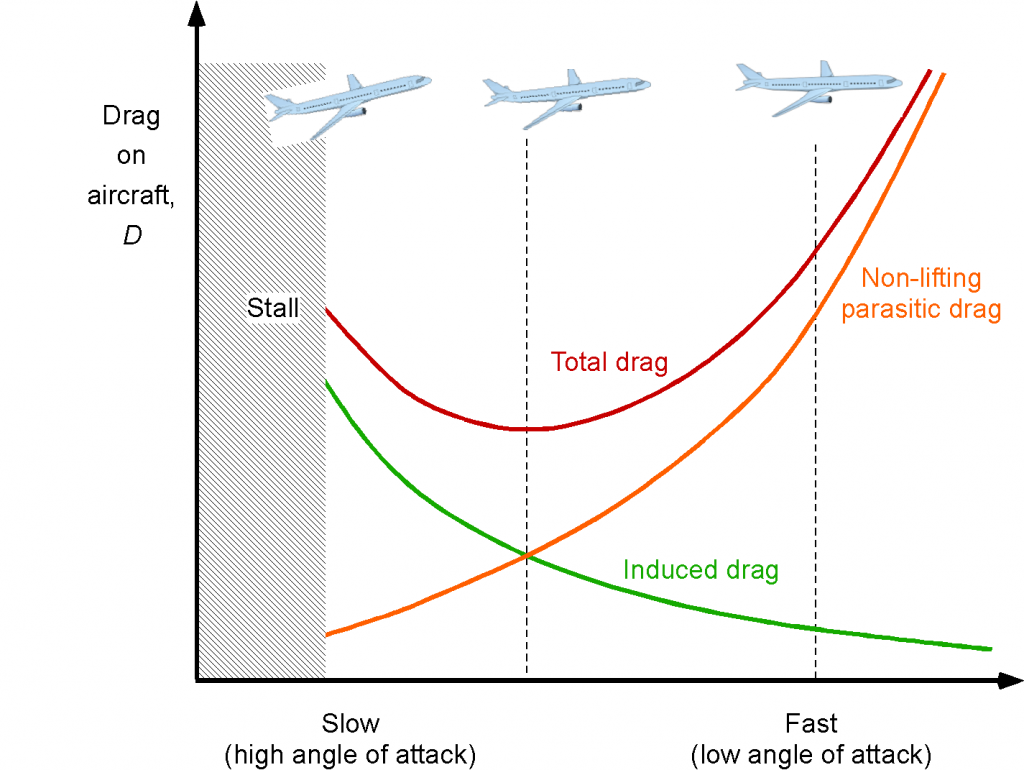
The corresponding power required for flight is
(46)
which is of the form
(47)
As airspeed increases, more power (and hence more fuel) is required for flight because power increases with the cube of airspeed.
Check Your Understanding #4 – Calculating the drag on a finite wing
Consider a flying wing with a wing area of 210 m2, an aspect ratio of 10, and an Oswald’s efficiency factor of 0.90. The airfoil section on the wing has a profile drag coefficient of 0.015. The airplane’s mass is 50,000 kg. If the airplane is flying at a density altitude of 3 km and the true airspeed is 230 m/s, then calculate the total drag on the airplane.
Show solution/hide solution.
The air density at a density altitude of 3 km is 0.90925 kg m-3 when using the ISA model. For vertical force equilibrium, the lift on the wing is equal to the weight of the airplane,
, i.e.,
The lift is given by
so the operating lift coefficient of the wing is
Inserting the known values gives
The drag coefficient is
where the non-lifting part , i.e.,
. Therefore, the total drag force is
which gives a corresponding lift-to-drag ratio of about 6.
Generalization of the Airplane Drag Polar
The drag produced on an airplane will also be a function of the Reynolds number and flight Mach number. Therefore, another generalization of the prior approach is to write that
(48)
although, again, the challenge is evaluating the values of the coefficients; this will usually involve a combination of wind tunnel measurements and flight tests.
Usually, for higher Mach numbers above 0.3, the effects of Mach number on the aerodynamics are more important than the effects of Reynolds number, so that Reynolds number variations can be ignored, i.e.,
(49)
Finally, the foregoing equations will apply to an airplane where the minimum drag is obtained at zero-lift conditions. If this is not the case, then a further generalization is to use
(50)
as shown in the figure below.

Winglets
The purpose of winglets is to increase the effective aspect ratio of the wing but without significantly increasing the wing’s span. The classic “Whitcomb” winglet moves the tip vortices from the wing tip to the top of the winglet, as confirmed in the photograph below. The consequence is that the tip vortices are further away from more of the wing, reducing the magnitude of the induced downwash all over the wing and decreasing its induced drag. The flow velocities induced by the tip vortices decrease inversely with distance, so even a small winglet can decrease the downwash velocities over the wing, measurably reducing drag.
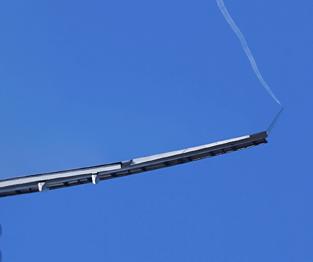
Today, airplanes have winglets by design or are retrofitted with them after delivery. The motivation is evident in that a winglet can reduce drag and save fuel. While the winglet adds some structural weight and produces a small increment in skin friction drag, the reductions in induced drag outweigh these concerns. Fuel savings can offset the cost of retrofitting a winglet to an airliner in as little as two years. Therefore, using a winglet makes sense rather than redesigning the wing with a higher span and aspect ratio.
A large “Jumbo” airliner’s feasible wingspan and aspect ratio may be limited for several reasons, including higher wing weight and the potential for aeroelastic issues. Airport operations, such as taxiway access, parking, and hangar size, also impose additional factors. The Boeing 777X is unique because of its extremely high wingspan and aspect ratio; it uses a folding wing tip design. The idea is to provide an ultra-high aspect ratio wing for flight while maintaining a reduced wing span on the ground; therefore, a winglet to boost the wing’s effective aspect ratio is unnecessary.

There are no validated theoretical formulas that can be used to calculate the effects of winglets, but one common approach is to use an aspect ratio correction of the form
(51)
where is the “effective” or corrected aspect ratio,
is the length or height of the winglet, as shown in the figure below, and
is an empirical coefficient that depends on the type of winglet.

For a classic Whitcomb winglet, it is usually assumed in Eq. 51 that , at least for preliminary design or airplane performance estimates. The lifting or induced component of the drag can then be written as
(52)
While winglets present some additional surface area to the flow and somewhat increase the profile (non-lifting) drag, the benefits are realized over the range of lift coefficients during flight, as shown in the figure below. Lift-to-drag curves for airplanes tend to be quite “peaky,” although the range of lift coefficients at which the highest lift-to-drag ratios can be maintained and even widened by sedulous airfoil and wing design. In this regard, the ability to maintain aerodynamic efficiency over a broader range of airspeeds, weights, and altitudes can be realized.
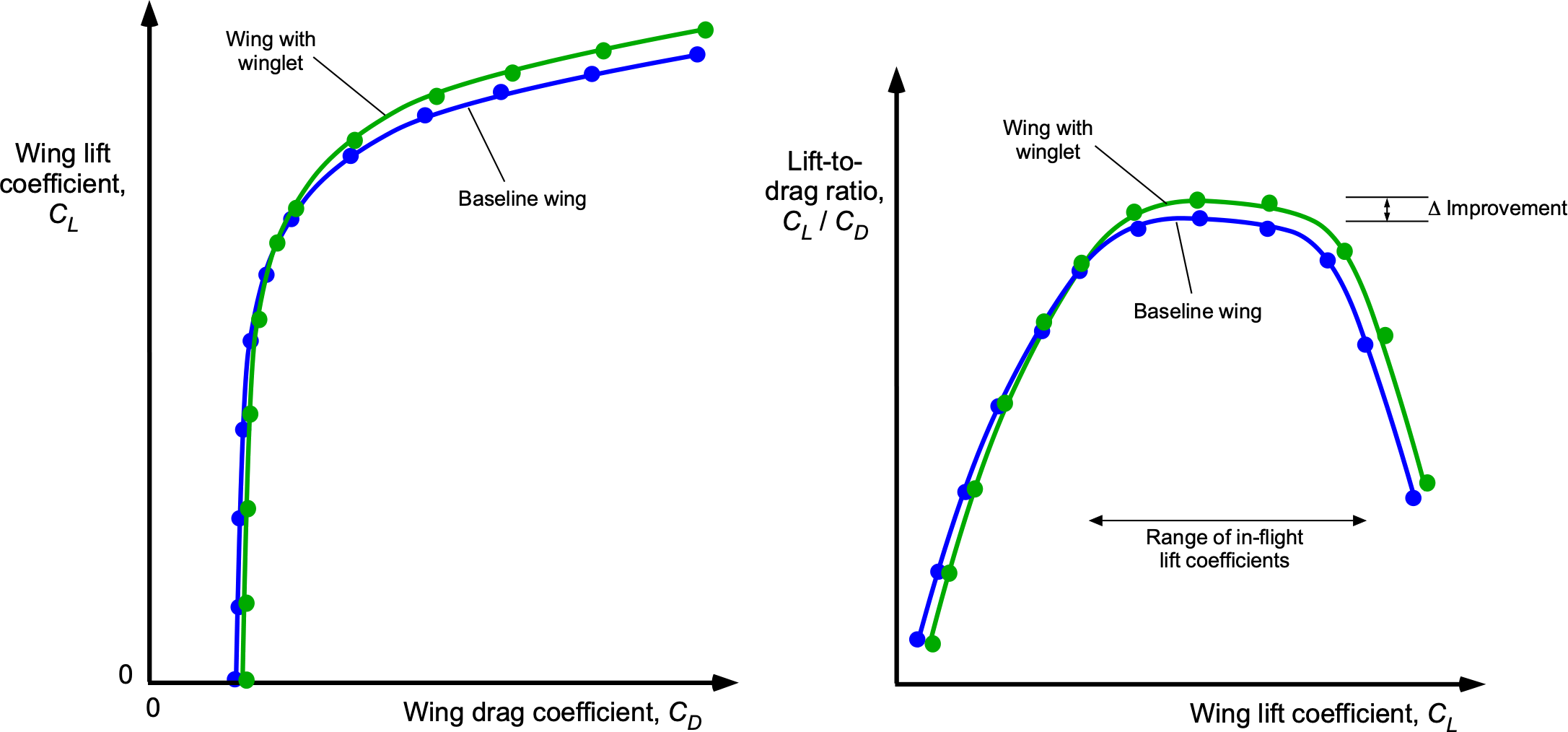
While the increase in lift-to-drag ratio using a winglet may only be a few percent relative to a baseline wing, the reductions in thrust required for a given airspeed can translate into substantial reductions in fuel burn during each flight. Actual fuel savings will depend on the aircraft type, flight length, and typical operating conditions. However, studies and industry data indicate that winglets can deliver significant fuel savings.
For example, a Boeing 737 equipped with blended winglets has been reported to achieve an average fuel savings of around 4% compared to the same airplane without winglets. Similarly, certain Airbus airplanes, such as the A350, fitted with blended winglets, have shown fuel savings of 3% to 4%. The upshot is that winglets can measurably extend an airliner’s flight range and/or increase its payload capacity.
While these performance benefits and resulting fuel savings might seem relatively modest, the high fuel consumption of commercial airliners and the large number of flights they operate mean that even a slight improvement in fuel efficiency can yield significant cost savings for airlines. Over the life of a commercial jetliner, which can exceed 25 years, the fuel savings can translate into millions of dollars for just one airplane. Therefore, fuel savings for a fleet of airliners at just one airline can reach tens or even hundreds of millions of dollars.
Effects of Compressibility & Wing Sweep
One issue to remember is that a wing’s drag increases rapidly as the flight Mach number approaches transonic conditions because of the development of shock waves and wave drag. However, such effects are difficult to generalize because the drag depends critically on the specific wing geometry (especially its thickness and sweepback angle) and operating lift coefficient.
The figures below show representative wind tunnel measurements of the minimum (non-lifting) drag on semi-span wings with different sweepback angles, , and different thickness-to-chord ratios,
. The transonic and supersonic drag will be minimized for a given sweepback by using as thin a wing as possible, bearing in mind that this may not be possible in practice for structural reasons. However, even with a thin wing, significant benefits can still be realized by using sweepback, especially in the supersonic regime.

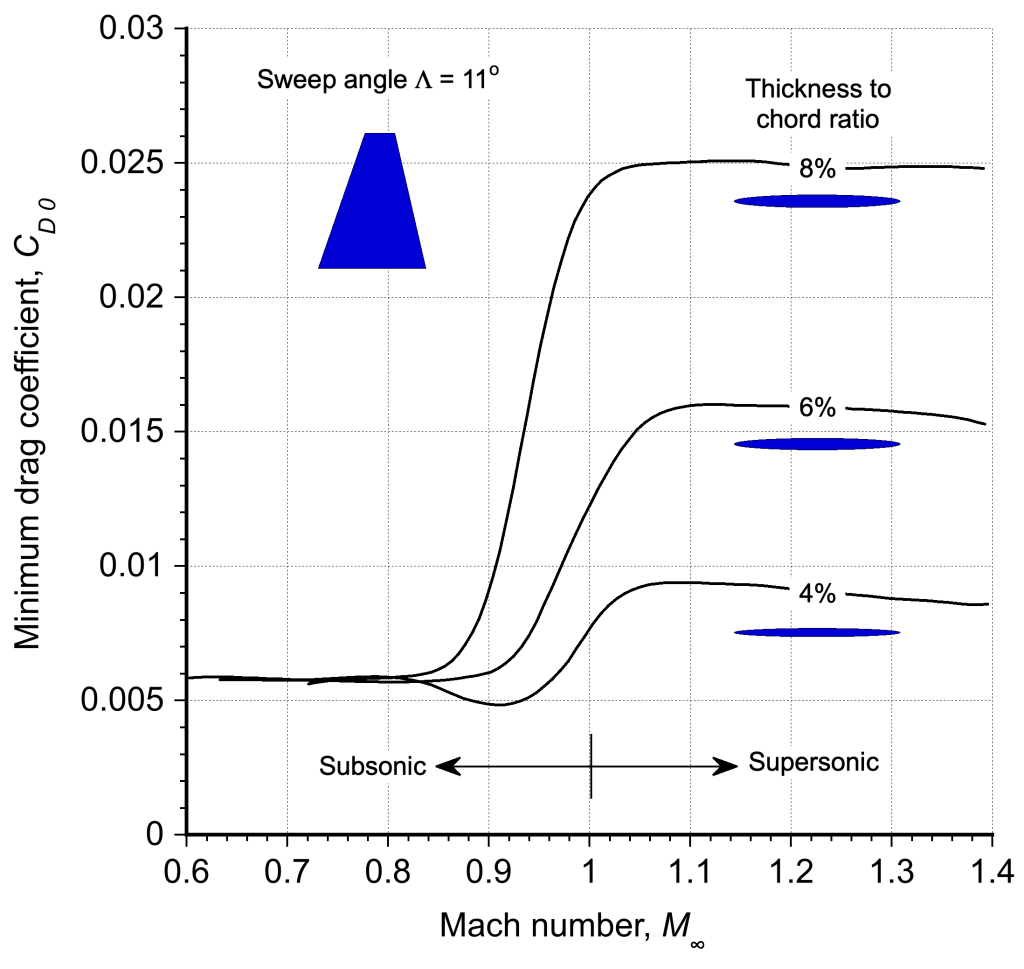
An approximate equation to quantify the increase in drag resulting from the formation of shock waves and the associated wave drag is known as “Lock’s fourth power rule.”[1] and the primary process has seen refinements and other developments by engineers over the years. The Lock model requires a value of the critical Mach number of the wing, , which is the flight Mach number at which the onset of supersonic flow first appears. Lock first argued that the drag of a shock wave per length (or its height extending from the surface of the wing) scales proportionally with the third power of the value of the flight Mach number above the critical Mach number, i.e., with
. Second, Lock argued that the height of the shock wave is also proportional to
. The net result is a wave drag increment proportional to the fourth power, i.e.,
. A constant
also appears in the final expression for the wave drag increment,
, i.e.,
(53)
which is valid for .
Therefore, including the wave drag increment, the drag equation for the airplane can be written as
(54)
where ,
, and
are all functions of Mach number. While the Lock equation has been found to give reasonably good predictions of the extra wave drag, quantitative predictions for specific airplanes depend on the value of
. Without any other information, a value
is often used for the preliminary design of an airplane, such as an airliner designed to cruise in transonic flight, where
. For airplanes with thin, supersonic airfoils with higher critical Mach numbers,
is appropriate.
Examples of Airplane Drag Polars
A combination of calculations (possibly using CFD), wind tunnel measurements, and flight tests can define the drag polar to an acceptable degree of fidelity for performance evaluations and other applications. Drag polars have been published for various types of airplanes, including general aviation, gliders, commercial, and military aircraft. One purpose of publishing such results is to allow engineers and analysts to validate their modeling and use it for instructional purposes.
An example of a complete drag polar for a legacy commercial airplane, shown in the figure below, is at higher subsonic Mach numbers and into the transonic domain. First, notice the increase in the zero-lift drag coefficient with increasing Mach number. Second, notice the more rapid growth in the drag as transonic conditions are approached and established (i.e., for
). This is the consequence of exceeding the critical Mach number and the development of shock waves, which leads to a commensurate increase in wave drag.
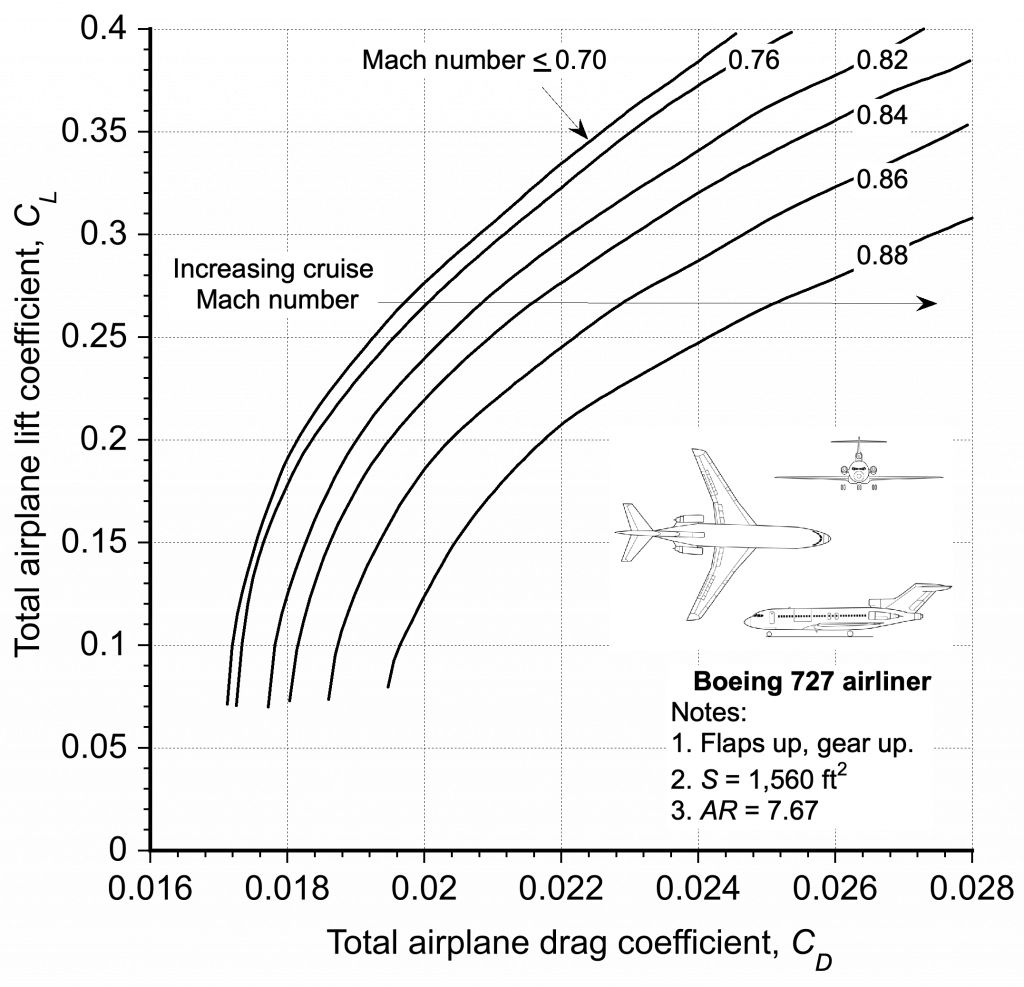
Another example of a drag polar is for a legacy military fighter airplane, shown below. In this case, the results are presented for subsonic, transonic, and supersonic flight conditions. Again, the rapid increase in drag is apparent as transonic conditions are encountered and supersonic flight is approached. Notice that the airplane has a lift-to-drag ratio of only about 3 in supersonic flight. For a military airplane, it is the usual practice to determine another form of the drag polar as a function of the load factor, i.e., for maneuvering flight.

Check Your Understanding #5 – Finding the lift-to-drag ratio of a wing
The drag coefficient of a particular airplane design is described by the equation
where is the aspect ratio of the wing. For aspect ratios of 10 and 20, determine the best lift-to-drag ratio of the wing and the lift coefficient at which this occurs.
Show solution/hide solution.
The drag coefficient for the airplane is given by
This means that
Differentiating the preceding expression gives
Therefore, solving for at this condition gives
This will be the lift coefficient used to obtain the maximum lift-to-drag ratio for a wing with a given aspect ratio.
For then the
for best
is
and substituting values with = 1.0 gives the best lift-to-drag ratio as
For then the
for best
is
and substituting values with = 1.41 gives the best lift-to-drag ratio as
Center of Pressure & Aerodynamic Center
The procedures for finding the center of pressure and aerodynamic center on a finite wing are similar to those for two-dimensional airfoils. Recall that, by definition, the center of pressure on a wing is a point about which the pitching moments are zero, i.e., a point where the resultant forces can be assumed to act. The aerodynamic center is a point where the moment is constant and independent of the angle of attack. Determining the aerodynamic center, like the center of pressure, requires values of the lift and moment coefficients versus the angle of attack about any other point, which is usually the 1/4-chord by default.
In the case of the center of pressure, then
(55)
Because the center of pressure is a moving point, it is not used much in practice to resolve the forces and moments on a wing.
If the aerodynamic center is assumed to be at a distance behind the leading edge, then
(56)
Differentiating the above equation with respect to gives
(57)
After rearrangement then
(58)
The value of can be obtained by using
(59)
This latter process is performed by finding the slopes of the best straight line fit to the values on the graphs of versus the angle of attack of the wing
and also the
curve versus
.
Vortex Wake Upsets
When viewed from the front of the airplane, the tip vortex from the left wing tip rotates counterclockwise, and the right one rotates clockwise, as the photograph below suggests. The vortices tend to be the strongest when the wing operates at high angles of attack, such as during takeoff and landing. As the tip vortices trail back from the wing tips, they descend behind the wing under their self-induced velocities.

While wing tip vortices affect the airplane that generates them, a concern is their persistence and potential effects on the following airplane. The generic name used for the impact of the vortex wake, especially by pilots and the FAA, is called wake turbulence. Wing tip vortices tend to be relatively strong and persistent and can remain for up to several minutes and many miles after the passage of an airplane through a given part of the sky. The persistence of the vortices also depends on the winds and other environmental factors, such as atmospheric turbulence.
Because the wingtip vortices persist and can take many minutes to dissipate, they can pose a concern for the following airplane, particularly in the terminal area. Additionally, the local downwash velocities may be a significant fraction of the airplane’s airspeed, accompanied by steep downwash gradients. This potential hazard is significant because it will affect the angle of attack and, consequently, the lift generated by the wing.
Notice from the figure below that an airplane may end up flying more perpendicularly or parallel to the wing tip vortices. On the one hand, flying nearly perpendicular to the vortices will cause the airplane to encounter an abrupt upwash followed by a downwash and then another upwash. This trajectory can cause significant changes in the airplane’s load factor during flight, which may concern passengers who experience a distinct “bump.” On the other hand, if an airplane flies parallel to the vortices, there is a tendency for the airplane to roll, which is a bad outcome. Hence the name vortex wake upsets becomes clear.
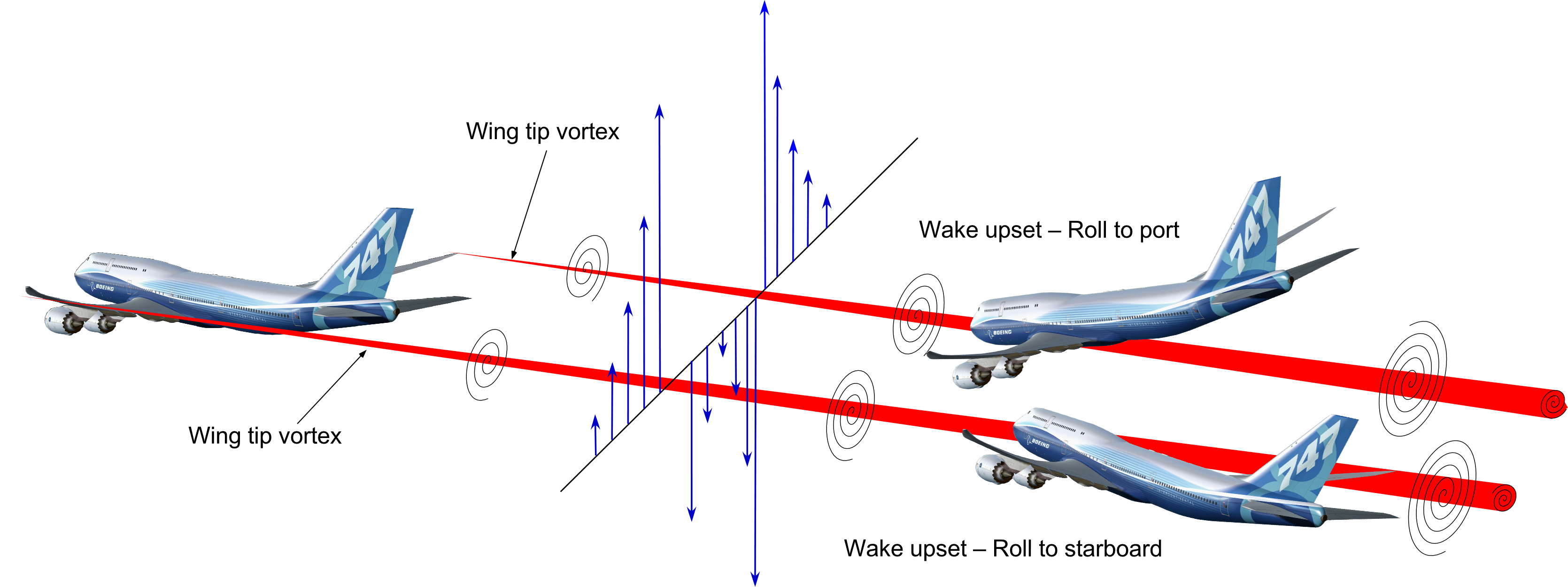
The possibility and problems of wake upsets during takeoff and landing operations became much more acute starting in the 1970s with the introduction of wide-body or jumbo jets such as the Boeing 747 and McDonnell-Douglas DC-10. The higher weights of these airplanes produced intense and persistent wing tip vortices that caused many “wake turbulence” incidents. The most prevalent were for smaller airplanes, which caused them to roll inverted in some cases of wake encounters.
Subsequently, the FAA has mandated much greater horizontal separation distances between all aircraft in the terminal airspace regions, thereby dramatically reducing the upsets from wake turbulence. However, increasing separation distances between aircraft limits the number of aircraft that can land and take off within a given time, which can seriously constrain aircraft movements at busy airports.
Summary & Closure
The aerodynamics of wings of finite span depend critically on their aspect ratio. The higher the aspect ratio, the lower the induced component of the drag. Induced drag is an inevitable consequence of lift generation and is highest when the wing operates at higher lift coefficients, thereby creating the strongest wing tip vortices. These vortices produce a downwash flow velocity over the wing, altering the lift and drag at every wing section. Therefore, the design of finite wings for minimum drag also depends on the spanwise lift distribution, which should be as close to elliptical as possible and can be achieved by judicious variations in planform (local wing chord), wing twist, and airfoil section.
5-Question Self-Assessment Quickquiz
For Further Thought or Discussion
- Calculate the potential improvement in lift-to-drag ratio for a wing when making a design change in the aspect ratio from 5 to 7 while keeping the same wing area. Make any reasonable assumptions.
- It said that a winglet increases the wing’s effective aspect ratio without an increase in its span. Discuss why.
- The drag polar for a high-speed airplane shows a general reduction in the slope of the curves when approaching and exceeding Mach 1. Discuss why this behavior occurs.
- Why does the aspect ratio of a wing become less important at supersonic speeds?
- Mandating greater separation distances between all aircraft in terminal airspace has reduced the likelihood of wake upsets but has led to other problems. Discuss.
Other Useful Online Resources
To understand more about the aerodynamics of finite wings, then, explore some of these online resources:
- Listen to Professor John Anderson discuss: The Wright Brothers Discover Aspect Ratio.
- Great educational film on: The Secret of Flight 8: The Induced Drag.
- To see more on vortex wake-induced drag, check out this animation and explainer.
- Read an interesting journal paper on the measurement of vortex wakes.
- A YouTube video showing aircraft wakes from natural condensation effects.
- The original work was published in the report: “The Ideal Drag Due to a Shock Wave Parts I and II,” ARC report 2512 (1951) by C. N. H. Lock,” ↵

